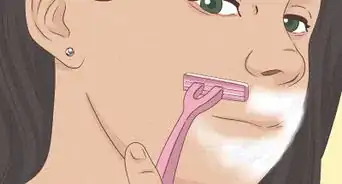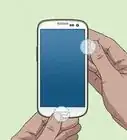This article was co-authored by Juan Sabino. Juan Sabino is a Professional Barber and the Owner of Juan's Barber Shop, a barbershop based in the San Francisco Bay Area. Juan has over 20 years of male grooming experience and over eight years of professional barber experience. He specializes in combovers, barber fades, and tapers and is focused on improving men's overall wellness.
There are 10 references cited in this article, which can be found at the bottom of the page.
This article has been viewed 69,229 times.
Cutting your skin while shaving can be surprisingly painful. If you're new to shaving, or have trouble with cutting yourself while shaving, it can be easy to get frustrated at all the nicks. But if you remember to use appropriate skincare, practice safe shaving techniques, and maintain and replace your razors, shaving can be an easy and safe experience.
Steps
Preparing Your Skin for Shaving
-
1Take a hot shower or bath to soften your skin before shaving.[1] Stay in the bath or shower for a few minutes to let your skin get moist; this will also help rid your skin of oils and dead skin cells that can clog your razorblade.[2] Wetting your hair with hot water will soften the skin, helping to prevent your razor from breaking the surface of it.[3] [4]
- 10 to 15 minutes is ideal, but any longer and your skin will start to wrinkle, making it harder to shave.[5]
- If you're only shaving your face, a few splashes of warm water will do, as will wetting a towel with warm water and wrapping it around your face for 5-10 minutes.
-
2Exfoliate your skin with a bristled brush or an exfoliating scrub. Let warm water run over your skin for a few minutes, then use the brush or scrub in a circular motion on the area you're going to shave.[6]
- Exfoliating scrubs may be labelled as "body scrubs" or "cleansing scrubs." These are best used when you're shaving your face.
- If you're shaving your body, an exfoliating brush will work better.
- Exfoliating rids your skin of dead skin cells, which can clog up your razor if left untreated.[7] A clogged razor is more likely to hop around your skin, leading to cuts or razor burns.
Advertisement -
3Use shaving cream or gel on the area you're going to shave.[8] Apply a liberal amount of shaving cream or gel across the area you're going to shave; it should be completely covered.[9]
- Shaving creams and gels will help a razor glide smoothly across your skin.[10] Not using a shaving cream can force the razor to jump across your skin, which will certainly lead to a cut.
- If you have excessively dry skin, look for “sensitive skin” shaving creams.[11]
- If you don’t have any shaving cream or gel, hair conditioner can work in a pinch.[12] You can also use soap lather.[13]
Shaving Correctly
-
1Shave with a sharp, clean razor.[14] Make sure that your razor is sharp, as razors with dull blades are more likely to cut you than sharp ones.[15]
- You can tell that your razor is beginning to dull when it tugs and nicks at your skin. This means that the blade isn't sharp enough to cut your hair and is pulling it instead.
- Make sure that your razor is free of moisture and rust before shaving: these can cause infections from bacteria.[16]
-
2Shave with the grain to avoid irritation.[17] Shaving towards the angle of hair growth (known as the “grain”) ensures that your razor travels smoothly, which will help you avoid cuts and razor burn.[18] [19]
- Identify the grain by running your fingertips through your hair. If your fingertips encounter resistance, you’re moving your fingers against the grain, whereas if your fingertips move smoothly across the hair, you’re moving with the grain.
- Some people shave their legs against the grain. However, only do this after your hairs are very short, since shaving against the grain while your hair is long could tug the hair from its follicle, which can irritate your skin.[20]
-
3Avoid pressing down on your razor when you shave. Applying a lot of pressure on the razor might seem like a good idea in theory, but since it’s pressing into your skin, the risk of a nick or cut is much greater.[21] Allow the weight of the razor to do the work for you; if it's sharp enough, it'll work.
-
4Use short strokes when shaving. Short strokes will ensure that you have control of the blade while you’re shaving.[22] It will also ensure that you hit every hair, whereas a long stroke might make you miss some hairs.
- If you're shaving your face, use strokes of 1–2 inches (2.5–5.1 cm).
- For the rest of your body, strokes of 2–4 inches (5.1–10.2 cm) will work.
-
5Go slow, and rinse the razor between strokes. Go slowly while shaving, and rinse the razor off every few strokes: this will keep the razor clean and more able to glide smoothly across your skin.
- Speeding through a shave makes it likely that you will cut yourself.
-
6Try multi-blade razors. As an option, try using razors with 4-5 blades instead of those with 1-2 blades. 1-2-blade razors are likely to drag against the skin, making it more likely that you will cut yourself.[23]
- Razors with four or five blades distribute pressure more evenly across your skin, which will give you a safer shave.[24]
Taking Care of Your Razor
-
1Rinse the razor with hot water after shaving.[25] Before you store your razor after shaving, be sure to rinse it in piping-hot water.[26]
- This will ensure that the razor is free from bacteria, dead skin, hair, and shaving cream, which could cause infection if left on the blade.
- If possible, leave the razor in alcohol to disinfect everything after each use.[27]
-
2Dry your razor thoroughly. Dry your razor with a clean towel before storing it. Getting rid of the liquid on the surface of the razor can help stop the spread of bacteria.
- If any fibers from the towel get stuck in the razor, use tweezers to pull them out; never use your fingers for this.
-
3
-
4Replace your razor's blades at the first sign of dullness.[30] Once your razor isn't cutting as well—when hairs are getting snagged in the blade instead of cut—replace the blades. Older, dull blades are less effective than sharp ones, and are more likely to cut you while shaving.[31]
- Depending on the blade, this could happen as soon as the fifth shave, so pay attention to how your razor is working.
Expert Q&A
Did you know you can get expert answers for this article?
Unlock expert answers by supporting wikiHow
-
QuestionWhat should I do if I got myself shaving?
 Marlon RivasMarlon Rivas is a Barber and Owner of MGX Professional Men's Grooming, a barbershop based in the San Francisco Bay Area. He is also the founder of Busystyle.com, a service that provides online scheduling services to businesses in the barbering and beauty industry. Marlon has over 15 years of experience in managing and providing barber services.
Marlon RivasMarlon Rivas is a Barber and Owner of MGX Professional Men's Grooming, a barbershop based in the San Francisco Bay Area. He is also the founder of Busystyle.com, a service that provides online scheduling services to businesses in the barbering and beauty industry. Marlon has over 15 years of experience in managing and providing barber services.
Facial Hair Specialist
-
QuestionIs it OK to shave daily?
 Juan SabinoJuan Sabino is a Professional Barber and the Owner of Juan's Barber Shop, a barbershop based in the San Francisco Bay Area. Juan has over 20 years of male grooming experience and over eight years of professional barber experience. He specializes in combovers, barber fades, and tapers and is focused on improving men's overall wellness.
Juan SabinoJuan Sabino is a Professional Barber and the Owner of Juan's Barber Shop, a barbershop based in the San Francisco Bay Area. Juan has over 20 years of male grooming experience and over eight years of professional barber experience. He specializes in combovers, barber fades, and tapers and is focused on improving men's overall wellness.
Professional Barber
-
QuestionIf want a very smooth shave and shave against the grain, how can I prevent nicks and cuts?
 Community AnswerUse a shaving conditioner or shaving gel, and avoid shaving cream or foam at all costs. Make sure you use a new razor blade and shave upward in a straight line. Remember to moisturize after!
Community AnswerUse a shaving conditioner or shaving gel, and avoid shaving cream or foam at all costs. Make sure you use a new razor blade and shave upward in a straight line. Remember to moisturize after!
References
- ↑ Marlon Rivas. Facial Hair Specialist. Expert Interview. 17 January 2020.
- ↑ https://www.aad.org/public/skin-hair-nails/skin-care/how-to-shave
- ↑ http://goaskalice.columbia.edu/answered-questions/proper-way-shave-beard
- ↑ Juan Sabino. Professional Barber. Expert Interview. 28 January 2020.
- ↑ https://www.goodhousekeeping.com/beauty/anti-aging/tips/a20754/mistakes-shaving-your-legs/
- ↑ https://www.glamour.com/story/how-to-shave-correctly
- ↑ Juan Sabino. Professional Barber. Expert Interview. 28 January 2020.
- ↑ Marlon Rivas. Facial Hair Specialist. Expert Interview. 17 January 2020.
- ↑ https://www.goodhousekeeping.com/beauty/anti-aging/tips/a20754/mistakes-shaving-your-legs/
- ↑ Juan Sabino. Professional Barber. Expert Interview. 28 January 2020.
- ↑ https://www.aad.org/public/skin-hair-nails/skin-care/how-to-shave
- ↑ https://www.glamour.com/story/how-to-shave-correctly
- ↑ Juan Sabino. Professional Barber. Expert Interview. 28 January 2020.
- ↑ Juan Sabino. Professional Barber. Expert Interview. 28 January 2020.
- ↑ https://www.glamour.com/story/how-to-shave-correctly
- ↑ https://www.aad.org/public/skin-hair-nails/skin-care/how-to-shave
- ↑ Marlon Rivas. Facial Hair Specialist. Expert Interview. 17 January 2020.
- ↑ http://www.menshealth.co.uk/style/grooming/grooming-myth-8
- ↑ Juan Sabino. Professional Barber. Expert Interview. 28 January 2020.
- ↑ https://www.goodhousekeeping.com/beauty/anti-aging/tips/a20754/mistakes-shaving-your-legs/
- ↑ https://www.glamour.com/story/how-to-shave-correctly
- ↑ https://www.cosmopolitan.com/uk/beauty-hair/a42420/shaving-hacks-legs-razor-tricks/
- ↑ https://www.goodhousekeeping.com/beauty/anti-aging/tips/a20754/mistakes-shaving-your-legs/
- ↑ https://www.goodhousekeeping.com/beauty/anti-aging/tips/a20754/mistakes-shaving-your-legs/
- ↑ Juan Sabino. Professional Barber. Expert Interview. 28 January 2020.
- ↑ https://www.gq.com/story/stop-ruining-your-razor
- ↑ Juan Sabino. Professional Barber. Expert Interview. 28 January 2020.
- ↑ https://www.gq.com/story/stop-ruining-your-razor
- ↑ https://www.glamour.com/story/how-to-shave-correctly
- ↑ Juan Sabino. Professional Barber. Expert Interview. 28 January 2020.
- ↑ https://www.goodhousekeeping.com/beauty/anti-aging/tips/a20754/mistakes-shaving-your-legs/
- ↑ https://www.gq.com/story/drop-the-toilet-paper-5-surprising-ways-to-stop-a-shave-cut-from-bleeding
About This Article
If you prepare your skin and use the proper technique while shaving, it’ll be much easier to prevent cutting yourself. Before you shave, take a brief, hot shower to soften your skin and get rid of dead skin cells that can clog your razor blade. It’s also helpful to exfoliate your face with a bristled brush while you’re in the shower. Once you’re out of the shower, apply enough shaving cream or gel to cover the whole area you want to shave. Pull a sharp razor across your face in slow, short strokes in the direction of the hair grain, which will avoid ingrown hairs. Avoid pressing down on the razor, since this will increase your risk of nicking yourself. Make sure to rinse your razor between strokes to remove any shaving cream and keep the razor working well. To learn how to take care of your razor so it stays sharp, read on!















-Step-14.webp)







-Step-10-Version-2.webp)











-Step-14.webp)





































